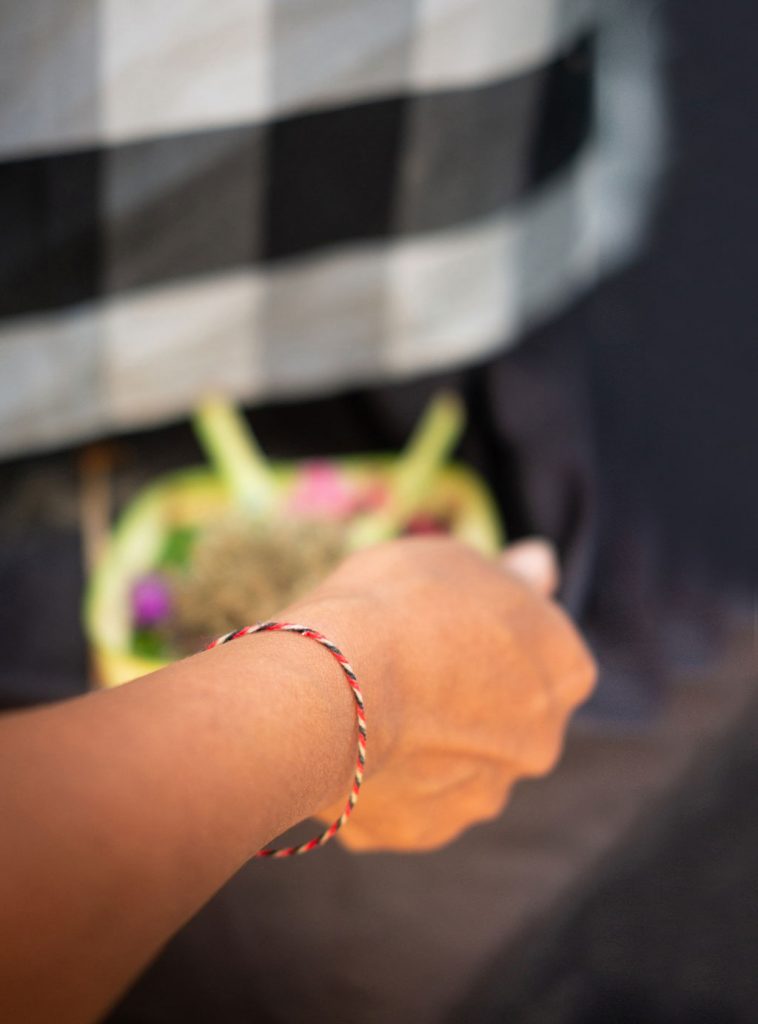Engraved onto pillars of houses and temples, donned by stone sculptures, and worn around people’s right wrists; the colours white, red, and black are omnipresent in Bali. It’s evident in many different forms, with the tri-coloured bracelets attached to the arm being the most common we see today.

The simple yet significant philosophy behind this unity of colours has become akin to the Balinese identity. White awakens goodness in spirit; red evokes creativity and bravery; whilst black is synonymous to power or protection from bad spirits.
Tridatu, if one were to translate it, means three powers. Almost comparable to the holy trinity, Tridatu embodies the Balinese-Hindu’s three manifestations of God otherwise known as the Trimurti. Brahma The Creator is represented in red; Siwa The Destroyer in white, and Wisnu The Preserver in black. Trimurti permeates through the core aspects of the Balinese-Hindu’s circle of life (birth, life, and death); captured by the three entities who hold the power or ‘duty’ of creation, welfare, and destruction for each stage of the life cycle.
Dating back as far as the 14th century, when the King of Bali, Dalem Watu Renggong reigned over The King of Nusa Dua, Dalem Bungkut, an agreement was settled. The latter and his companion Ratu Gede Mecaling were to grant authority of Nusa to the King of Bali, and in return, Wanggung promised to protect the Hindu people — those who are particularly faithful to God. Whereas those who are disobedient to God and the Hindu teachings will be punished by Ratu Gede Mecaling. The Tridatu’s presence around the wrist was to signify one’s devotion and obedience, therefore free from the wrath of Mecaling.
Legend has it, the very distinct sound of Kulkul Pajenengan, an ancient Balinese ‘instrument’ would ring before every punishment. It now resides in Puri Agung Klungkung; and whenever it is heard on arbitrary days, the Balinese anticipates a disaster coming.
Not only is it a day-to-day requisite today, the triumvirate is also an essential element of religious rituals. Back in the olden days, it was present during sacrifices where the animal’s blood would be used to represent red, chalks to make white, and charcoal for black. On specific holy days, the Tridatu colours are fashioned by male temple-goers, whose typical outfit is a black shirt, white sarong, and a red over-skirt. The dress implies their soundness to receive a blessing from God.
Then, there’s the Tridatu yarn bracelet. Worn by the Balinese-Hindu strictly around the right wrist, gelang Tridatu may appear as a simple yarn-threaded bangle. But it’s a symbol of godly power and ‘magic’.
No matter how the Tridatu is donned, the sacred item is blessed with prayers to endow the wearer with purity and longevity. Its main purpose is to cleanse the mind, preventing negative influences to be present in one’s life, essentially keeping one’s thoughts crystal clear. It’s more than a colourful accessory, and certainly not merchandise. It acts as a ‘charm’ that paves way for positive vibrations. The same bracelets you see in retail waiting to be sold to tourists bear no meaning behind them.
In its most hallowed form, the bracelet is purified by holy water, blessed by a Hindu priest and is given out at ceremonies for protection beyond the holy ritual; with each one mindfully weaved. The consecrated process behind the ‘gift’ also acts as a reminder to always live life in accordance to the teachings of Trimurti. In essence, every breath of life will meet its end; hence, the philosophy (in the shape of a bracelet or ceremonial clothes) reminds the recipient that the ‘in-between’ should be done in good will which ultimately decides how their life will conclude.
The Balinese believe that the gelang Tridatu will eventually detach or ‘disappear’ by its own accord. Then, much like life or samsara, the cycle begins again.









